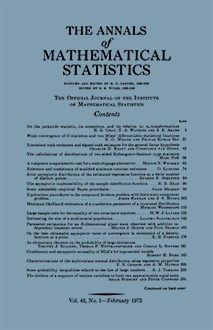Abstract
In an election return with two candidates $A$ and $B$, if $\alpha_r$ is the number of votes for $A$ in the first $r$ counted, $\beta_r$ the similar number for $B$, then $r$ is a $c$-lead position for $A$ if $\alpha_r > \beta_r + c - 1$. With final vote $(n, m) (n$ for $A, m$ for $B$), what is the number $l_j(n, m; c)$ of returns with $j c$-lead positions? Or, what is the enumerator $l_{n m}(x; c) = \sum l_j(n, m; c)x^j$ of election returns by number of lead positions? For $c = 0, \pm 1, \pm 2, \cdots$ it is shown that all enumerators may be expressed in terms of $l_{n m}(x; 0)$ and $l_{n m}(x; 1)$, which are given explicit expression.
Citation
John Riordan. "The Enumeration of Election Returns by Number of Lead Positions." Ann. Math. Statist. 35 (1) 369 - 379, March, 1964. https://doi.org/10.1214/aoms/1177703760
Information





